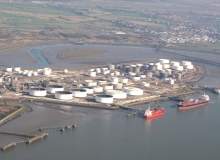
The Coryton crude oil refinery is located in Essex on the Thames Estuary, southeast UK. It is spread over 586 acres and has a total throughput capacity of 220,000 barrels a day (bpd). The refinery can process 175,000bpd of crude and nearly 65,000bpd of other feedstocks.
The refinery was built in 1953 by Vacuum Oil Company, a unit of Mobil. It was run by BP, under a joint venture agreement with Mobil, from 1996.
The ownership of the refinery was transferred to BP in 2000 after Mobil merged with Exxon. BP sold the refinery to Petroplus Holdings for $1.4bn in 2007.
Major products of the refinery include petrol and diesel, aviation fuels, liquefied petroleum gas, fuel oils and bitumen. Most of the products are marketed in southeast UK.
The refinery supplies the majority of the bitumen required by the UK market. Certain products such as gasoline and fuel oil are exported outside the UK.
Facilities
The refinery consists of a crude distillation unit (CDU), vacuum distillation unit (VDU), fluid catalytic cracker (FCC), gas recovery unit, isomerisation unit, hydro desulphurisation units, continuous catalytic reformer, alkylation unit, lube base oil production units and other utilities.
Crude oil is supplied to the refinery through five jetties. The jetties have a capacity to handle tankers of up to 250,000t deadweight.
Finished products are transported from the refinery by a truck-loading rack, oil product pipeline (UKOP Thames / Mersey pipeline) and marine facilities.
Extension / developments
The isomerisation unit was added in 1993. Its construction required excavation of 20,000m3 of soil and driving of more than 700 piles at the site.
A central control building was added to the refinery in 1997. The existing control buildings, administrative and amenities buildings, other utilities and access roads were upgraded at the same time.
The FCC was upgraded in 2002 with a new 350t reactor. The new reactor was installed as the internal structure of the old one was gradually deforming.
BP launched the Clean Fuels Gasoline Project to produce higher specification sulphur free fuels in 2003. The project, which was commissioned in August 2003, included construction of a selective hydrogenation unit (SHU), inter-plant connections, utilities, offsite tankage and pipework upgrades.
It posed several construction challenges such as the lifting of the SHU fractionator column. The column weighed 115t with a length of 46m and a diameter of 2.5m. It was lifted in place with the help of a 1,500t crane.
Petroplus upgraded the refinery’s low voltage equipment in 2011 as they had become obsolete. Schneider Electric supplied its Masterpact NW circuit breakers for the refinery.
Processing
Crude oil is fed into the CDU where it is separated into fractions in the atmospheric distillation tower. Various components of the crude oil are separated in the distillation tower and collected in trays.
The crude oil is further processed to remove sulphur and other impurities to improve its octane rating.
The residue from the base of the distillation tower is removed and processed in the FCC. A catalyst is added in the FCC to distil the heavy oil to produce gasoline and diesel.
The heaviest residue from the distillation tower is redistilled in the VDU. It is then converted into bitumen, lubricating oils and wax.
Technology
The refinery is equipped with rosemount analytical continuous emissions monitoring (CEM) systems supplied by Emerson Process Management.
The system includes gas analysers which use a combination of sensors, digital signal processing and software technologies to measure carbon monoxide, carbon dioxide, oxides of nitrogen, sulphur dioxide and oxygen levels.
Contractors
Foster Wheeler constructed the isomerisation unit under a £70m contract. The company was also awarded the engineering, procurement and construction contract for the Clean Fuels Gasoline Project.
A joint venture of Jackson Lane and Mott MacDonald constructed the central control building of the refinery.

